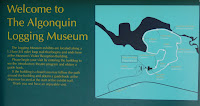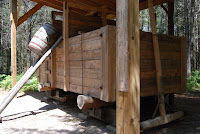
A visit to the museum actually involved a walking tour. The museum covers two eras of Algonquin logging, the “square timber” and the “sawlog” eras. The tour started with a video and then took us down a wooded trail back to the 1830s, to a replica of one of the earliest camboose shanties, which was a very 
During the early logging they squared off the 40+ foot tall virgin timbers sent back to England aboard ships. The trees were much taller, but any part containing branches was considered waste. Even though there was a lot of wasted wood by our standards, the squared timbers fit nicely in the ships’ holds without wasting space or shifting. Some of the broad axe heads used to square off the timbers weighed 12 pounds! Imagine swinging that for hours a day!
As we walked along the museum trail we saw a replica stable where horses were kept. Many of the men who logged during the winter were farmers during the spring and summer. They would 
Displays housed snow plows and water tanker sleighs used to maintain icy tracks upon which the huge horse drawn log sleighs travelled. The maintenance was all done at night so the tracks could freeze firmly before morning. The other problem, however,
was the sleigh going too fast, running over the horses, spilling the load and injuring or killing the driver. Being innovative, they either shoveled hot sand on the spots that were too steep or 


Log Chute
Slowly the quality of shelter and food evolved to the sawlog era, the later 1800s and early 1900s, and eventually there were separate bunk houses and dining halls. The cookery resembled a large kitchen and dining hall and actually had tables and benches. The men still weren’t allowed to talk during a meal – it distracted the cook, and fresh baked bread was withheld for a couple of days so no one would eat more than their share. We learned that the food offered in the later sawlog camps included corned beef, vegetables, tea, beans, prunes, butter and jam. This was considered a vast improvement over the diet of their predecessors. The reason they referred to this as the sawlog era was that at this point there were saw mills in nearby towns and the timbers were just cut and shipped to the mill. They didn’t have to do anything but saw logs and ship them.
The afternoon we spent at the Logging Museum was beautiful and warm. It was peaceful vacation day. There was a lovely breeze and only a few people wandered around the grounds. It was in total contrast to what we had just learned about the beginnings of Algonquin logging: frigid winter weather, backbreaking labor, noise, danger, and poor, crowded living conditions. I am really glad I am not a logger, then or now. However, our visit gave me an appreciation of how hard the men worked to help their families survive in this harsh northern area and how innovative they were in creating equipment and processes they needed to make their rugged job easier.
Author ringing the dinner bell at the Sawlog Cookery. It was LOUD!
Sunday evening Lake of Two Rivers, Algonquin Provincial Park, Loons.
All week we had gone back and forth by the Lake of Two Rivers to evening programs. I wanted to take pictures of the lake and island because it was so beautiful. One evening we forgot the 

Loons on Lake of Two Rivers



No comments:
Post a Comment